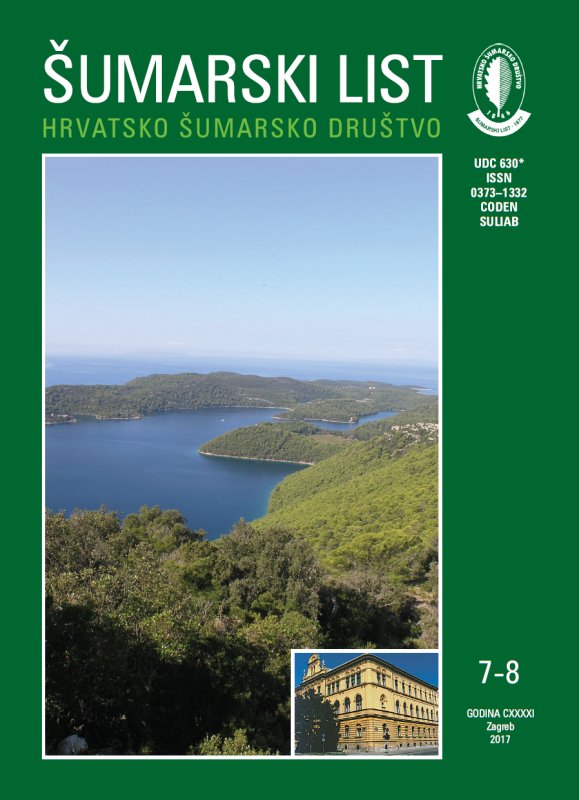
broj: 7-8/2017
pdf (25,6 MB) |
|
||||||||||||||
| RIJEČ UREDNIŠTVA | ||
| Uredništvo | ||
| ON THE 20TH ANNIVERSARY OF THE DAY OF CROATIAN FORESTRY pdf HR EN | 337 | |
| IZVORNI ZNANSTVENI ČLANCI | ||
| Ante ŠILJEG, Ivan MARIĆ, Mladen JURIŠIĆ, Ivan PLAŠČAK | UDK 630* 165 (001) https://doi.org/10.31298/sl.141.7-8.1 | |
| VIEWSHED MODEL AS A STRATEGY FOR PREVENTION OF FOREST FIRES – CASE STUDY OF ZADAR COUNTY pdf HR EN | 339 | |
| Dalibor BALLIAN, Ute TRÖBER | UDK 630* 165 (001) https://doi.org/10.31298/sl.141.7-8.2 | |
| GENETIC CHARACTERIZATION OF EUROPEAN BLACK POPLAR (Populus nigra L.) IN BOSNIA AND HERZEGOVINA pdf HR EN | 351 | |
| Ebru BILICI,Mehmet EKER,Mesut HASDEMIR, Abdullah E. AKAY | UDK 630* 433 + 379 (001) https://doi.org/10.31298/sl.141.7-8.3 | |
| ASSESSMENT OF POST-FIRE SALVAGE LOGGING OPERATIONS IN MEDITERRANEAN REGION OF TURKEY pdf HR EN | 363 | |
| Summary Various problems such as massive volume loss, erosion, degradation of water resources, and air pollution emerge after forest fire incidents. Thus, necessary forest operations should be quickly planned and implemented after forest fires so that afforestation activities can take place immediately to maintain forest vegetation in burned areas. The aim of this study was developing a Post-fire Action Planning (PFAP) model to minimize the time spent on salvage logging activities. PFAP model will assist decision makers for removing salvage timber in a timely manner after large scale forest fires, while considering economic and environmental constraints, and dealing with available employment conditions in local forest industry. The capabilities of this model were examined by standardizing the operational planning and developing a fast decision-making process. The model was implemented in Taşağıl Forest Enterprise Chiefs (FEC) of Antalya Forest Regional Directorate where the forests are sensitivity to fire at the first degree level and the second largest forest fire in the history of Turkish Forestry occurred in this area in 2008. The findings of PFAP model were compared with the data of actual salvage logging operation obtained from the FEC. The results indicated that using operational planning based PFAP model is capable of reducing total time spent on salvage logging operation by about 60%. Based on the forestry compartments of the study area, estimated durations of salvage logging operations were 15 to 75 days less than that of actual operations taken place in the field. Therefore, it is highly anticipated that using operational planning based PFAP model has great potential to provide economically and environmentally sound forest operations after forest fires. Key words: Forest fire; Salvage logging; Forest transportation; Operational Planning; Modelling | ||
| Erhan ÇALIŞKAN, Uzay KARAHALIL | UDK 630* 614 + 360 (001) https://doi.org/10.31298/sl.141.7-8.4 | |
| HARVEST SCHEDULING AND OPERATIONAL PLANNING FOR MOUNTAINOUS AREAS: A CASE STUDY FOR IKISU PLANNING UNIT pdf HR EN | 375 | |
| PRETHODNO PRIOPĆENJE | ||
| Osman MUJEZINOVIĆ, Mevaida MEŠAN, Mirza DAUTBAŠIĆ, Kenan ZAHIROVIĆ | UDK 630* 453 https://doi.org/10.31298/sl.141.7-8.5 | |
| MONITORING OF POPULATIONS OF BROWNTAIL MOTH (Euproctis chrysorrhoea L.) IN THE CENTRAL BOSNIA pdf HR EN | 387 | |
| PREGLEDNI ČLANCI | ||
| Matija LANDEKIĆ, Ivan MARTINIĆ, Matija BAKARIĆ, Rosa M. RICART, Mario ŠPORČIĆ | UDK 630* 969 https://doi.org/10.31298/sl.141.7-8.6 | |
| VOCATIONAL TRAINING OF WORKERS IN THE FORESTRY SECTOR – THE SITUATION IN CROATIA AND TRENDS IN EUROPE pdf HR EN | 395 | |


